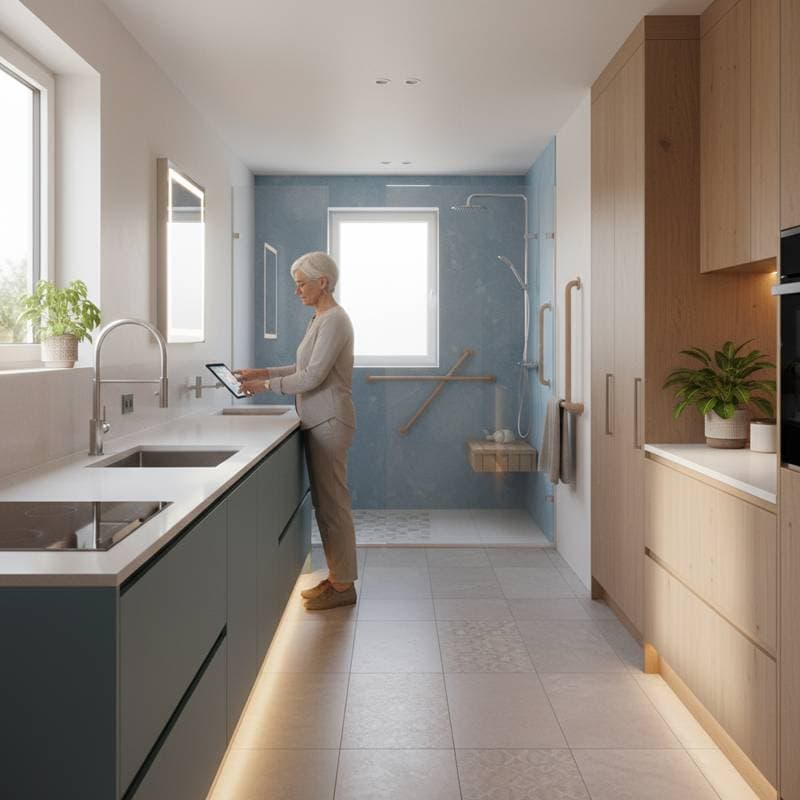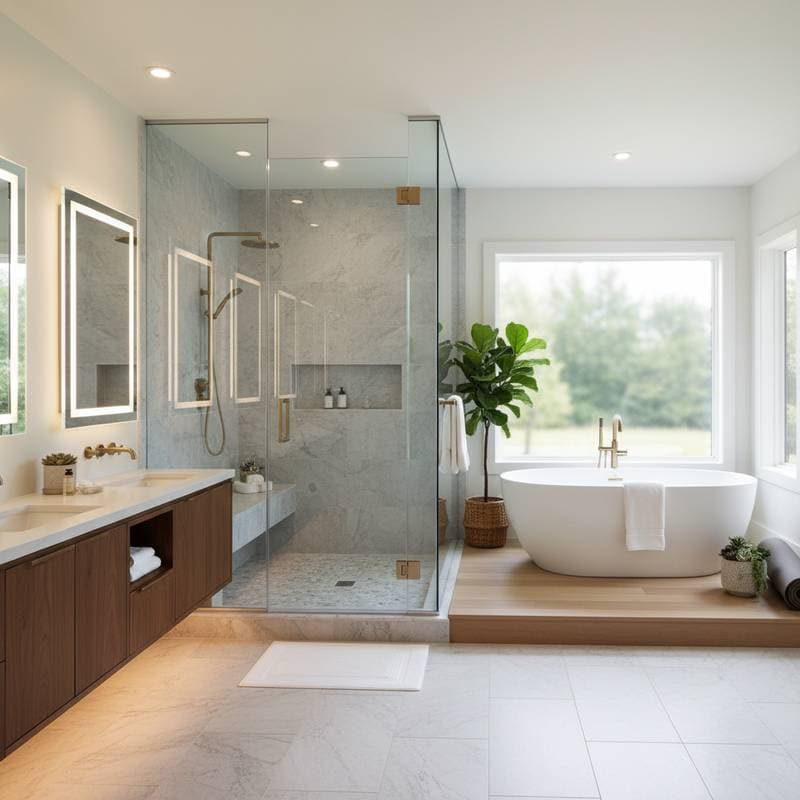2025 Costs: Making Your Home Accessible for Aging
Quick Overview
This guide details the process of remodeling your home to support accessibility as you age. It addresses common upgrades, provides realistic cost estimates, and distinguishes between tasks suitable for do-it-yourself efforts and those requiring professional expertise. Readers gain insights into planning from initial design through ongoing maintenance to ensure the home remains safe, comfortable, and functional for years to come.
Home modifications for aging in place focus on eliminating barriers that could lead to falls or limit mobility. These changes range from simple additions like grab bars to comprehensive alterations such as installing ramps or redesigning bathrooms. By understanding costs and timelines, homeowners can prioritize projects that align with their budget and future needs.
DIY vs Professional Guidance
When You Can Safely DIY
Homeowners with basic tools and carpentry experience can handle minor accessibility updates without significant risk. These projects involve straightforward installations that enhance safety without altering the home's core structure.
Examples include:
- Securing grab bars in bathrooms or along hallways to provide stable support during transfers.
- Swapping traditional doorknobs for lever-style handles that require less grip strength.
- Placing non-slip mats or adhesive strips on slick floors to reduce slip hazards.
- Upgrading to brighter LED bulbs or adding motion-activated lights in key areas like stairwells.
Such tasks typically demand no permits and can complete in a weekend, allowing for immediate improvements.
When to Hire a Professional
Engage a licensed contractor for any work that impacts structural integrity, plumbing, or electrical systems. Professionals bring expertise in local building codes, ensuring modifications meet safety standards and avoid costly errors.
Projects necessitating professional involvement encompass:
- Widening doorways or removing walls to accommodate wheelchairs or walkers.
- Converting tub-shower combinations into roll-in showers with curbless entries.
- Installing stairlifts, platform lifts, or residential elevators for multi-level homes.
- Overhauling kitchens or bathrooms to include lower counters and reachable storage.
Cost comparison: Materials for DIY small-scale updates often total less than $1,000, covering items like hardware and adhesives. Professional services for comparable installations range from $2,000 to $5,000, factoring in labor and compliance checks. Major remodels, such as a full bathroom conversion, may exceed $20,000 but include warranties and insurance against defects.
Tools and Materials List
Equipping yourself with the right tools and materials ensures efficient and safe work. Select items that meet durability standards, particularly for load-bearing features.
Tools:
- Cordless drill and screwdriver set for precise fastening.
- Stud finder to locate secure mounting points in walls.
- Retractable tape measure for accurate dimensions.
- Bubble level to confirm even installations.
- Protective safety glasses and work gloves to prevent injuries.
- Circular saw with fine-tooth blade for any cutting tasks.
Materials:
- Grab bars constructed of stainless steel, rated to support at least 250 pounds.
- Lever-style door handles and rocker-light switches for ease of use.
- Non-slip flooring options like vinyl tiles or textured rugs.
- Adjustable showerheads with hose extensions for versatile positioning.
- ADA-compliant toilets with comfort-height seats and wall-mounted sinks.
- Portable ramps or door threshold reducers made from aluminum.
- Energy-efficient LED lighting fixtures with wide beam spreads.
Budget $200 to $500 for a basic toolkit if starting from scratch, and source materials from home improvement stores for quality assurance.
Troubleshooting and Quality Checks
Even well-planned projects encounter issues; addressing them promptly maintains functionality. Focus on common pitfalls during and after installation.
Common problems and fixes:
- Grab bar pulls from wall: Secure with toggle bolts or mount directly into wall studs using a stud finder.
- Water pooling in shower: Regrade the floor slope toward the drain or reposition the drain for better flow.
- Door too narrow for wheelchair: Enlarge the opening to a minimum of 36 inches wide, consulting a contractor for framing adjustments.
- Uneven ramp surface: Reinforce with additional supports or shim the base to achieve a consistent incline no steeper than 1:12 ratio.
Quality checks:
Navigate all modified pathways by walking or simulating wheelchair use to verify at least 36-inch clearances.
Employ a level across ramps, floors, and installed fixtures to detect any tilts.
Operate lighting switches, outlets, and controls multiple times to confirm reliability.
Run water through plumbing modifications to assess flow rates, temperature consistency, and complete drainage without backups.
Conduct these evaluations immediately after completion and revisit seasonally.
Maintenance and Lifespan
Regular upkeep extends the value of accessibility features, preventing wear that could compromise safety. Integrate checks into your household routine for sustained performance.
Routine care:
Examine grab bars and railings for loose bolts every six months; tighten or replace as necessary.
Refresh non-slip surfaces by replacing mats or strips once they lose traction.
Verify the operation of motion sensors and automated lights on a monthly basis.
Clear debris from door tracks, ramp surfaces, and thresholds to avoid tripping hazards.
Typical lifespan:
Grab bars endure 10 to 15 years with proper anchoring.
Non-slip flooring lasts about 10 years, varying with foot traffic.
Lighting fixtures function for 5 to 10 years before bulb or component replacement.
Ramps withstand 15 to 20 years if shielded from extreme weather and inspected annually.
Pro Tips for Success
Strategic planning maximizes efficiency and cost savings in accessibility remodels. Consider these expert recommendations to future-proof your space.
Group related upgrades, such as bathroom fixtures and hallway lighting, to streamline labor and permitting processes.
Incorporate high-contrast colors between walls, floors, and edges to aid visual navigation for those with reduced sight.
Opt for adjustable elements like extendable shower wands and height-variable shelving to adapt to changing abilities.
Designate a main-floor bedroom and full bathroom as accessible hubs to minimize stairs usage.
Account for advanced needs, including 60-inch wheelchair turning circles in rooms and space for medical devices like hospital beds.
Consult aging-in-place specialists early to map out a phased approach, starting with high-impact, low-cost changes.
Frequently Asked Questions
How much does it cost to make a bathroom wheelchair accessible?
A complete remodel, including a roll-in shower, reinforced grab bars, and ADA-compliant fixtures, typically ranges from $15,000 to $30,000. Costs vary by location, materials, and existing layout; obtain multiple quotes for accuracy.
Do I need a permit for an accessibility remodel?
Permits are mandatory for modifications involving structural, electrical, or plumbing alterations. Contact your local building department to review plans and avoid fines or redo work.
Can I use my existing bathroom layout and still make it accessible?
In many cases, yes, provided the space accommodates a 5-foot turning radius and unobstructed shower access. Minor tweaks like adding bars and lever faucets often suffice without full redesign.
Are accessibility upgrades tax deductible?
Certain medical necessity-driven modifications qualify as deductions under IRS guidelines. Speak with a tax advisor to determine eligibility based on your situation and documentation.
What is universal design?
Universal design creates environments usable by individuals across all ages, abilities, and sizes without requiring adaptations. Examples include wide doorways and intuitive controls that benefit everyone.
Sustaining Accessibility Over Time
Investing in home modifications fosters ongoing independence and security as mobility evolves. Initiate with essential safety enhancements like improved lighting and handles to yield quick benefits. Advance to broader adaptations, such as entry ramps or zero-step showers, for enduring support. Collaborate with certified professionals for complex tasks, adhere to a maintenance schedule, and reassess needs periodically. This approach enables confident aging in place while preserving the home's welcoming essence.










